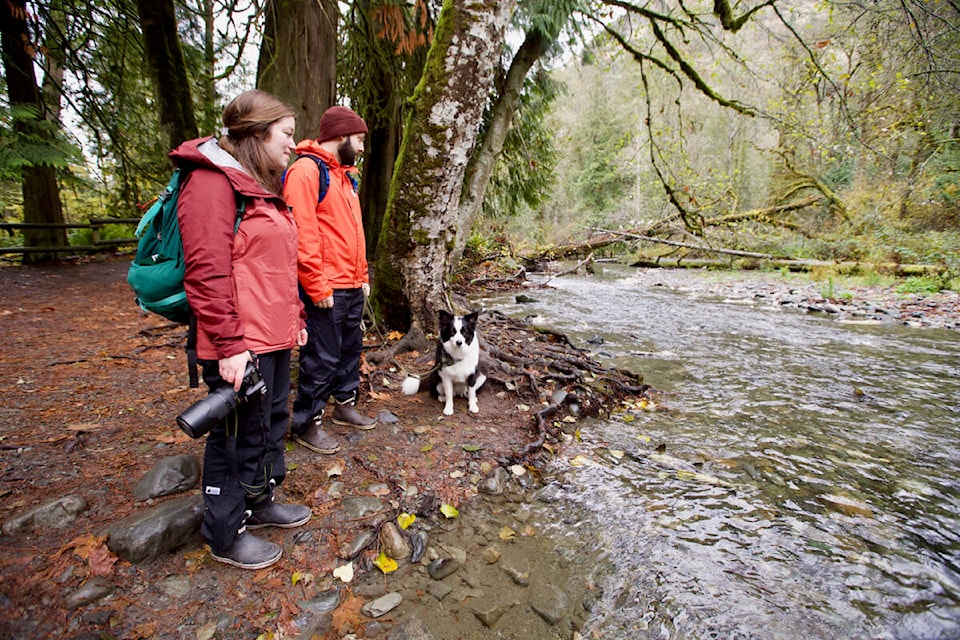Goldstream River saw the salmon return to nearly double its target this year, according to Fisheries and Oceans Canada.
Goldstream’s success was part of a trend of runs further south succeeding, whereas runs north of Nanaimo largely struggled.
Northern Island runs tend to happen earlier in the year, according to Kevin Pellett, a Strait of Georgia stock assessment biologist with FOC – in October or for some species in the spring or summer – while runs in Greater Victoria like the Goldstream River peak in November, by which time temperatures had cooled and the area had seen some rain.
Summer drought fuelled low water levels and led to dystopian die-offs of salmon on the mainland in October. But that didn’t pan out on the Island, said Pellett. The lingering warm conditions led to warm and shallow waters, especially in shallower creeks.
That delayed some salmon runs.
“Undoubtedly in some areas, we likely had higher losses – pre-spawn mortality, as we call them – so that can be anything from just prolonged waiting, anything from water temperature catching up to them, to even predation,” said Pellett.
But Pellett said the wait times likely didn’t have much of an impact. Mostly the Island’s salmon runs were saved by the fact they broadly take place later in the year – the runs that happen further south on Vancouver Island seemed to fare better broadly because they happen later.
The success of runs varied by species. Many of the chinook salmon runs in major rivers south of Nanaimo saw higher-than-expected numbers. Those larger rivers, like Nanaimo and Cowichan, were insulated from the later start times, although the shallower waters meant fish had fewer spots to spawn and were concentrated around the centre of the river.
For chinook salmon, the earlier runs struggled, with the summer runs in Puntledge Lake and Nanaimo River below the targeted number of fish, but the fall runs on average met their targets or exceeded them.
In southern Vancouver Island, chum salmon saw something of a rebound year, coming after several years of drastically lower returns, particularly in the Cowichan River (up from around 25,000 in 2021 to more than 100,000 in 2022, still below the 12-year average of around 161,000). In Goldstream, the chum salmon this year nearly doubled the target of 15,000, with peaks estimates coming in at 33,535 fish. Nanaimo River was right around the four-year average of 49,000 (still below the 12-year average of around 65,000).
The success of the chum salmon this year remains something of a mystery to those in the field, said Pellett. Around Greater Victoria, the entrance to the Strait of Georgia mixes with other straits like the Haro Strait – that area often has cooler waters and the runs happen later in the year.
The unpredictable conditions are hard on the salmon and are also hard on those doing the monitoring, Pellett said. The salmon fence in Cowichan River, a barrier made out of PVC piping that helps count the fish, had one of its shortest use seasons since the program began in 1988.
“It’s pretty interesting this year that the story was the low water and the drought, and last year the story was high water and all the rain. So I think the picture that we’re seeing is greater variation in the weather patterns and stream closing conditions. It’s not like they’re consistently becoming drier or wetter. I think it’s we’re getting both drier and wetter, depending on what the year gives us. But that’s one of the things that we’re having to adapt to … It’s becoming more challenging for us to even get some of these counts, just with the wild variation we’re seeing.”
READ MORE: Goldstream salmon run should hit targets
READ MORE: ‘Flabbergasting’ lack of rain has returning salmon dying in droves on B.C. central coast
bailey.moreton@goldstreamgazette.com
Like us on Facebook and follow us on Twitter.



